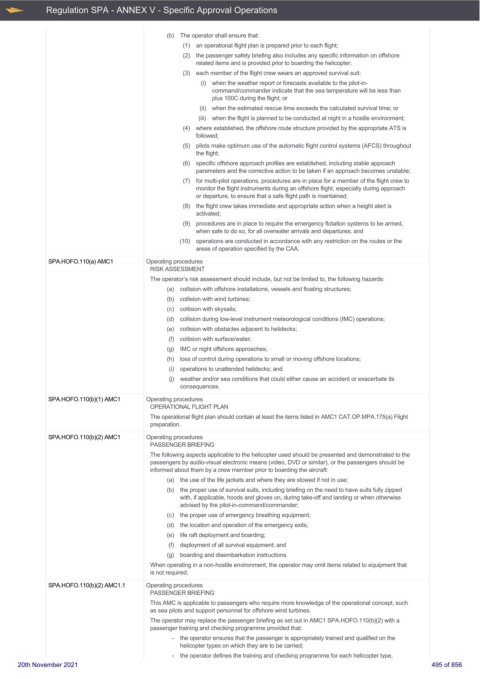Page 495 - UK Air Operations Regulations (Consolidated) 201121
P. 495
~
~ Regulation SPA - ANNEX V - Specific Approval Operations Centrik
(b) The operator shall ensure that:
(1) an operational flight plan is prepared prior to each flight;
(2) the passenger safety briefing also includes any specific information on offshore
related items and is provided prior to boarding the helicopter;
(3) each member of the flight crew wears an approved survival suit:
(i) when the weather report or forecasts available to the pilot-in-
command/commander indicate that the sea temperature will be less than
plus 100C during the flight; or
(ii) when the estimated rescue time exceeds the calculated survival time; or
(iii) when the flight is planned to be conducted at night in a hostile environment;
(4) where established, the offshore route structure provided by the appropriate ATS is
followed;
(5) pilots make optimum use of the automatic flight control systems (AFCS) throughout
the flight;
(6) specific offshore approach profiles are established, including stable approach
parameters and the corrective action to be taken if an approach becomes unstable;
(7) for multi-pilot operations, procedures are in place for a member of the flight crew to
monitor the flight instruments during an offshore flight, especially during approach
or departure, to ensure that a safe flight path is maintained;
(8) the flight crew takes immediate and appropriate action when a height alert is
activated;
(9) procedures are in place to require the emergency flotation systems to be armed,
when safe to do so, for all overwater arrivals and departures; and
(10) operations are conducted in accordance with any restriction on the routes or the
areas of operation specified by the CAA.
SPA.HOFO.110(a) AMC1 Operating procedures
RISK ASSESSMENT
The operator’s risk assessment should include, but not be limited to, the following hazards:
(a) collision with offshore installations, vessels and floating structures;
(b) collision with wind turbines;
(c) collision with skysails;
(d) collision during low-level instrument meteorological conditions (IMC) operations;
(e) collision with obstacles adjacent to helidecks;
(f) collision with surface/water;
(g) IMC or night offshore approaches;
(h) loss of control during operations to small or moving offshore locations;
(i) operations to unattended helidecks; and
(j) weather and/or sea conditions that could either cause an accident or exacerbate its
consequences.
SPA.HOFO.110(b)(1) AMC1 Operating procedures
OPERATIONAL FLIGHT PLAN
The operational flight plan should contain at least the items listed in AMC1 CAT.OP.MPA.175(a) Flight
preparation.
SPA.HOFO.110(b)(2) AMC1 Operating procedures
PASSENGER BRIEFING
The following aspects applicable to the helicopter used should be presented and demonstrated to the
passengers by audio-visual electronic means (video, DVD or similar), or the passengers should be
informed about them by a crew member prior to boarding the aircraft:
(a) the use of the life jackets and where they are stowed if not in use;
(b) the proper use of survival suits, including briefing on the need to have suits fully zipped
with, if applicable, hoods and gloves on, during take-off and landing or when otherwise
advised by the pilot-in-command/commander;
(c) the proper use of emergency breathing equipment;
(d) the location and operation of the emergency exits;
(e) life raft deployment and boarding;
(f) deployment of all survival equipment; and
(g) boarding and disembarkation instructions.
When operating in a non-hostile environment, the operator may omit items related to equipment that
is not required.
SPA.HOFO.110(b)(2) AMC1.1 Operating procedures
PASSENGER BRIEFING
This AMC is applicable to passengers who require more knowledge of the operational concept, such
as sea pilots and support personnel for offshore wind turbines.
The operator may replace the passenger briefing as set out in AMC1 SPA.HOFO.110(b)(2) with a
passenger training and checking programme provided that:
- the operator ensures that the passenger is appropriately trained and qualified on the
helicopter types on which they are to be carried;
- the operator defines the training and checking programme for each helicopter type,
20th November 2021 495 of 856

